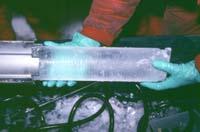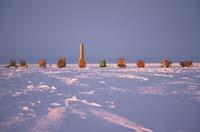Antiquity records in Antarctic ice

Experts do not agree on whether these phenomena are rare or are part of the Earth's natural cycle. For this it is essential to know the evolution of the climate, how it has evolved since time immemorial.
But where to look at the temperature and precipitation data of that time? In the ice of Antarctica. The composition of the ice depends on the temperature of the snow season, so the study of the composition allows to know the temperature. In addition, the air bubbles trapped in the ice are samples of the atmosphere of the time.
For all this, scientists have dug Antarctic ice in various areas to get deep to take the oldest possible samples. They remove full columns of ice for continuous registration and store them and carefully take them to the laboratory for study. In view of news from Antarctica, it seems that scientists compete to get the oldest ice sample. And lately the records have come one after another.
A million years

Scientists extract entire columns of ice to maintain a continuous record.
(Photo: Mark Curran/ Australian Antarctic Group)
The last news was given by the Japanese: a group of scientists from this country has drilled the ice of Antarctica up to more than three kilometers deep and has managed to extract a sample of ice of a million years. If this is so, it is the oldest so far.
The exact date will be made in April, when the sample will be sent to Japan. Scientists are satisfied that since 2003 work was being done on obtaining this sample. Now they have to investigate. Among other things, they want to see how the proportion of gases in the atmosphere has changed. It is also intended to analyze the impact of investment in the Earth's magnetic field on the climate some 790,000 thousand years ago.
In fact, the polarity of the Earth's magnetic field varies periodically. Currently, the negative pole is near the north geographic pole, but in periods between 10,000 and 25,000 years this polarity is exchanged. Now scientists have the opportunity to see how these investments affect the climate.
Europeans also happy

There are several groups that are drilling ice with the same objective of studying climate evolution.
(Photo: Vin Morgan/ Australian Antarctic Group)
A few days before the Japanese announced their achievement, European scientists announced the same thing, that they had extracted an ice column of a depth of 3,000 meters and that, although it was shorter than that obtained in 2004, it seemed as old as that. That is, they thought he was about 900,000 years old.
As already mentioned, later, the Japanese surpassed (supposedly) the record of seniority, which does not detract from what was achieved by the Europeans. So far the water from the ice samples came from the Indian Ocean and the Pacific. The water in the current sample corresponds to the Atlantic. This allows them to understand what happened in the Atlantic Ocean and to know where the Earth, in the north or in the south, or the changes that have occurred simultaneously in both.
At the moment, local and local scientists have obtained valuable samples and from now on they will conduct numerous studies in laboratories to, on the one hand, understand the past of the Earth's climate and, on the other, extract lessons for the future.
Published in 7K.
Buletina
Bidali zure helbide elektronikoa eta jaso asteroko buletina zure sarrera-ontzian











